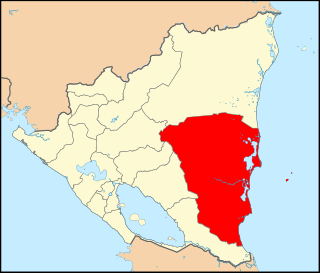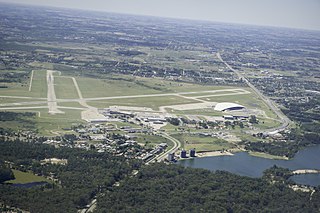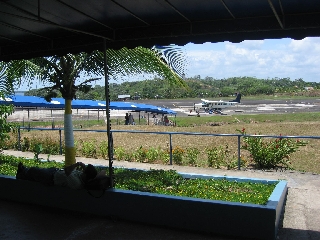
Luis Muñoz Marín International Airport is a joint civil-military international airport located in suburban Carolina, Puerto Rico, three miles (5 km) southeast of San Juan. It is named for Luis Muñoz Marín, Puerto Rico's first democratically elected governor, and was known as Isla Verde International Airport until it was renamed in February 1985. It is the busiest airport in the Caribbean region by passenger traffic. Over 4 million passengers boarded a plane at the airport per year according to the Federal Aviation Administration, making it the 48th busiest airport overseen by said federal agency.

Mercedita International Airport (AIM) is an international airport located three nautical miles (6 km) east of the central business district of Ponce, Puerto Rico. The airport covers 270 cuerdas of land and has one runway. It was inaugurated as an international airport on 1 November 1990. It was built with combined funds from the Municipality of Ponce and the Commonwealth of Puerto Rico.

Rafael Hernández International Airport is a joint civil-military airport located in Aguadilla, Puerto Rico. It is named after the Puerto Rican composer Rafael Hernández Marín. It is Puerto Rico's second largest international airport in terms of passenger movement. It is located in Porta del Sol tourist region, in Puerto Rico's west coast. It is also home to Coast Guard Air Station Borinquen and to the Caribbean Branch of the U.S. Customs and Border Protection Air and Marine Operations. The airport has the longest runway in the Caribbean region.

Augusto C. Sandino International Airport, or ACS, is the main joint civil-military public international airport in Managua, Nicaragua. It is named after Nicaraguan revolutionary Augusto Nicolás Sandino (1895–1934) and is located in the city's 6th ward, known locally as Distrito 6. Originally christened Las Mercedes Airport in 1968, it was later renamed Augusto C. Sandino International Airport during the Sandinista government in the 1980s and again in 2001 to Managua International Airport by then-president Arnoldo Alemán. Its name was changed once more in February 2007 to its current name by President Daniel Ortega to honor the revolutionary. Managua also has an alternative landing strip at Punta Huete Airport. Punta Huete was designed for larger aircraft and thus has a longer landing strip. This alternative landing site, however, does not service commercial aircraft. The airport is managed by the state-run Administrative Company of International Airports, more commonly known as the EAAI, given its Spanish name, the Empresa Administradora de Aeropuertos Internacionales.

Olaya Herrera Airport is an airport located in Medellín, Colombia, that serves regional and domestic flights. Additionally, the airport is used by general aviation and features several hangars for charters.

The South Caribbean Coast Autonomous Region is one of two autonomous regions in Nicaragua. It was created along with the North Caribbean Coast Autonomous Region by the Autonomy Statute of 7 September 1987 through a division of the former Zelaya Department. It covers an area of 27,260 km2 (10,530 sq mi) and has a population of 420,935. The capital is Bluefields. Bordering the Caribbean Sea, it contains part of the region known as Mosquitia.

Carrasco/General Cesáreo L. Berisso International Airport is the main international airport of Uruguay. It is the country's largest airport and is located in the Carrasco neighborhood of Montevideo. It has been cited as one of the most efficient and traveler-friendly airports in Latin America.

Bellingham International Airport is three miles (5 km) northwest of Bellingham, in Whatcom County, Washington, United States. BLI covers 2,190 acres (886 ha) of land, and is the third-largest commercial airport in Washington.

Punta Cana International Airport is a privately owned commercial airport in Punta Cana, eastern Dominican Republic. The airport was built with open-air terminals and roofs covered in palm fronds. Grupo Punta Cana built the airport, which was designed by architect Oscar Imbert, and inaugurated it in December 1983. It is owned by Grupo Punta Cana and became the first privately owned international airport in the world.

Juan Manuel Gálvez International Airport is an international airport located on the island of Roatán, in the Caribbean Sea 50 kilometres (31 mi) off the northern coast of Honduras. Roatán is in the Bay Islands Department of Honduras.

Terrance B. Lettsome International Airport, previously known as Beef Island Airport, is the main airport serving the British Virgin Islands, a British overseas territory in the Caribbean. The airport serves as the gateway to just about all of the islands within the BVI. The airport is also a gateway for inter-Caribbean travelers headed to the nearby U.S. Virgin Islands. Many travellers fly into Beef Island, with the intention of taking a ferry to the other smaller British Virgin Islands. The airport is located on Beef Island, a small island off the main island of Tortola, to which it is connected by the Queen Elizabeth II Bridge.

Albury Airport is a regional airport located 2 nautical miles northeast of Albury, Australia. The airport, which also serves Albury's adjacent twin city of Wodonga. It hosts the official weather station for Albury-Wodonga.

Bluefields International Airport is an airport serving Bluefields, a harbor city in the South Caribbean Coast Autonomous Region of Nicaragua. It is the busiest airport in the Caribbean coast of Nicaragua.

Canouan Airport is the airport located on the island of Canouan in St. Vincent and the Grenadines. The airport serves the surrounding tourist areas and environs of the Grenadines and is a major destination during the Caribbean winter leisure season. Aside from facilitating regular passenger flights, the airport is also open for international corporate jet operations and charter flights. Canouan Airport was the main business aviation airport in St. Vincent and the Grenadines before the opening of Argyle International Airport. The terminal has a CIP lounge and other facilities for international passengers and a domestic hub for St. Vincent and the Grenadines. It is the second largest airport in St. Vincent and the Grenadines, after Argyle International Airport. The airport often served as the alternate airport for E.T. Joshua Airport, now a decommissioned airport in St. Vincent and other Grenadines airports.
Fabio Alberto León Bentley Airport is an airport serving Mitú in the Vaupés Department of Colombia. It is next to the Vaupés River and runs along the entire length of the city.

Simón Bolívar International Airport is an international airport serving the city of Santa Marta, Colombia. The airport is located 14 kilometres (8.7 mi) south of Santa Marta city center, on the shores of the Caribbean Sea. 18 kilometres (11 mi) north of the municipality of Ciénaga in Colombia.

Andres Miguel Salazar Marcano Airport is an airport serving Isla de Coche, an island in the Venezuelan state of Nueva Esparta.
Guanaja Airport is an airport serving Guanaja, an island of the Bay Islands Department in Honduras.
Punta Huete Airport is an airport located in the municipality of San Francisco Libre in Managua, Nicaragua. The airport is in a sparsely populated section of the municipality. The nearest town is San Benito, 14 kilometres (9 mi) to the east.
Emerald Coast Airport is an international airport 10 kilometres (6.2 mi) west of Tola, a town in the Rivas Department of Nicaragua. The airport was opened on November 15, 2015, at a cost of almost US$13 million.






















